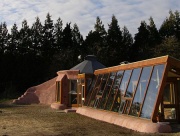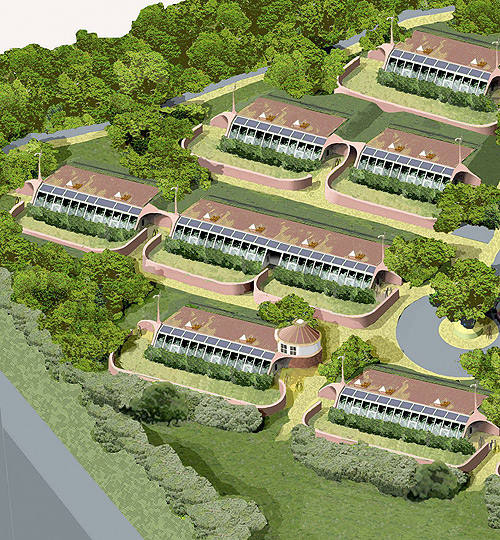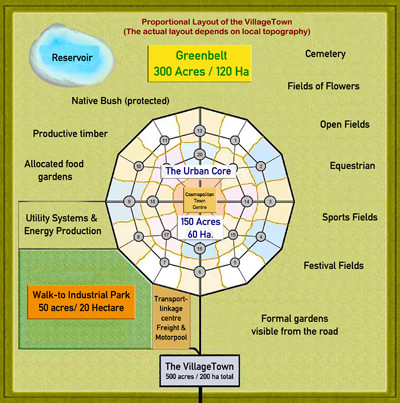Difference between revisions of "User:Tim/Habitation Main"
| Line 16: | Line 16: | ||
An earthship is a dwelling designed for of the grid living. It is designed are maximized to | An earthship is a dwelling designed for of the grid living. It is designed are maximized to | ||
| − | + | * need only the sun for heating | |
| − | + | * natural air flows for cooling | |
| − | + | * capture, filter and reuses rain so no additional water supply is needed | |
| − | + | * use solar, wind and batteries to provide enough electricity continuously | |
| − | + | * build in green house to provide an amount of food | |
| + | * build using recycled materials | ||
[[Habitation_Earth_Ship Earthship main article]] | [[Habitation_Earth_Ship Earthship main article]] | ||
| + | |||
| + | == Townhouse == | ||
| + | |||
| + | <Still gathering material to make a town using more sustainable technology> | ||
| + | |||
| + | == City == | ||
| + | |||
| + | [[File:Earthshipvillage.jpg]] | ||
| + | |||
| + | A village using earthships can be build but it will resemble a more rural landscape. Every earthship needs lot of space to get enough light and plants. This of course makes the distances within the village larger, so the need for cars become (probably) necessary. | ||
| + | |||
| + | [[File:VillageTown Example.jpg]] | ||
| + | |||
| + | According to certain experts <ref name=Kent Larsons TED talk>[[http://www.ted.com/talks/kent_larson_brilliant_designs_to_fit_more_people_in_every_city.html]]</ref> <ref name="Claude Lewenz at VillageTowns">[[http://villagetowns.net]]</ref>, a city works best if everything people needs for their daily chores are within 10 minutes walk. A city with 10.000 people has to be divided into smaller villages where every village contains all basic shops and other daily necessities like a doctor. | ||
| + | |||
| + | Clause Lewenz also remarks that the upper limit for a village is 10.000 inhabitants. Above that, government and bureaucracy becomes increasingly difficult. So a hard limit, a physical wall around the village itself, is needed. So city works best if it's divided into smaller villages. | ||
| + | |||
| + | == References == | ||
| + | |||
| + | {{Reflist}} | ||
Revision as of 08:38, 19 March 2013
Contents |
Habitation
Habitation comes in many forms. People can live in a solitary house or in dense cities. These settlements need completely different infrastructure.
Concrete Tent
One form of easy deploy-able shelter is the [Concrete Canvas Shelter]. It is a tent, made of canvas filled with concrete. It comes in an airtight package to prevent contact with water as water. To deploy the tent, the concrete is activated by adding water to the package is needed. The package itself is constructed so that as the package is completely filled with water, the mixture water/concrete is exactly right. After that, the tent can be unfolded and inflated with an air compressor. After 48 hours, the concrete is dry and the shelter is read for use. It has a life time for up to 50 years if needed.
Using this tent is practical for the first settlers, to have some some durable shelter and storage immediately available. It is cheaper and relatively easier to transport than comparable structures and provides a good isolation from the environment.
Earthships
An earthship is a dwelling designed for of the grid living. It is designed are maximized to
- need only the sun for heating
- natural air flows for cooling
- capture, filter and reuses rain so no additional water supply is needed
- use solar, wind and batteries to provide enough electricity continuously
- build in green house to provide an amount of food
- build using recycled materials
Habitation_Earth_Ship Earthship main article
Townhouse
<Still gathering material to make a town using more sustainable technology>
City
A village using earthships can be build but it will resemble a more rural landscape. Every earthship needs lot of space to get enough light and plants. This of course makes the distances within the village larger, so the need for cars become (probably) necessary.
According to certain experts [1] [2], a city works best if everything people needs for their daily chores are within 10 minutes walk. A city with 10.000 people has to be divided into smaller villages where every village contains all basic shops and other daily necessities like a doctor.
Clause Lewenz also remarks that the upper limit for a village is 10.000 inhabitants. Above that, government and bureaucracy becomes increasingly difficult. So a hard limit, a physical wall around the village itself, is needed. So city works best if it's divided into smaller villages.



